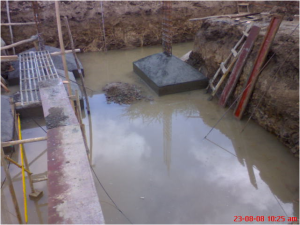From a trivial trickle of water in the foundation pit to flooding in excavated pits to under water concreting , a construction person interacts with water in different challenging situations.
This article brings to you the various situations where water has to be properly dealt with on the construction sites.
1.Water from subsoil is trickling in the foundation pit :
This is a tricky issue because if there is water in the pit it is difficult to pour concrete in the raft of footing.
In such situation make a small sump pit in a corner and put the suction of thede-watering pump in this sump.
Keep the casting team ready and as soon as water level in the pit comes below the raft level, start the concrete.
It is advised to keep the Water /cement ratio less than 0.4 so that mixing of pit water in the concrete do not make it more fluid. In simpler words make a dense concrete since there is already water in the pit.

Not presently disruptive.It is indicative of the fact that waterproofing has not been carried out around the pit.
2.Surface rain water flooding in the pit :
If the PCC & Raft are already completed we just have to wait for dry spell for binding the column cage ,shuttering and casting it.
However, if both PCC & Raft are pending then take actions as per case no 04.
3. Water from subsoil trickling in Pile bore :
This can happen in any season of the year. During pile boring ,Bentonite slurry can be used to stabilize the sides.Concreting can be done after removal of water by injecting compressed air.Use ofTremie is must for depositing concrete in the pile.

The yellow colour is due to the bentonite powder.
4. Water filled up in mass excavation just before the leveling course:
This can become quite serious issue in case water has also started scouring the sides of the pit.
To avoid further collapse of soil inside pit , provide strutting to the weak sides.
Put couple of de-watering pumps .
When the water has almost drained out carry out rubble soling on the pit bottom to make it level & workable.
Complete the leveling course with PCC now.Complete the raft & columns at war level.
5.Other liquids flowing in the pit:
Sounds interesting no ?
In one of the industrial projects , we came across a situation when concentrated hydrochloric acid started oozing out from the sides of the pit.
On inquiry we found that acid storage tanks were erected in the front yard of that company. The spillage was collected in the basin.The acid used to get a direct underneath passage from basin up to the location of the expansion on the rear side.

HYDRO-CHLORIC ACID OOZING OUT FROM AN OPEN PIT.
The acid was to be neutralized using chemicals ,then excavated then only work continued.
6.Underwater concreting in open foundation( river or sea ):
In case the sub strata is such that an open footing has to be done below the water we have two conventional methods:
6.1 By using caissons:
Caisson is a specially designed reinforced concrete pipe of diameter larger than the foundation to be cast.
1.Shift the caisson to location of the foundation.
2.Sink it vertically under water so that one end firmly penetrates in the silt.Heights of caisson is made such that the other end of this pipe is slightly above water level.
3. Start de-watering from the caisson
4.Complete the excavation in the caisson .
5. Complete the foundation work.
6. Back-fill the caisson with suitable material . caisson permanently remains in this location. This becomes a portion of the pier.
6.1 By using cofferdam:
3. Complete the excavation within the cofferdam
4. Complete the foundation work.
7. Underwater concreting for Pile foundation ( river or sea ):






One thought on “Water Water everywhere !”